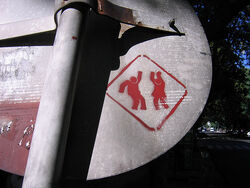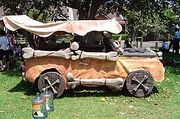
Dance zone
Reclaim the Streets (RTS) is a collective with a shared ideal of community ownership of public spaces. Participants characterize the collective as a resistance movement opposed to the dominance of corporate forces in globalisation, and to the car as the dominant mode of transport.
Protests[]

The Barney Rubble Mobile a mobile sound system used by RTS in Sydney, Australia
Reclaim the Streets often stage non-violent direct action street street reclaiming events such as the 'invasion' of a major road, highway or freeway to stage a party. While this may obstruct the regular users of these spaces such as car drivers and public bus riders, the philosophy of RTS is that it is vehicle traffic, not pedestrians, who are causing the obstruction, and that by occupying the road they are in fact opening up public space. The events are usually spectacular and colourful, with sand pits for kids to play in, free food and music. A Temporary Autonomous Zone sometimes results. The style of the parties in many places has been influenced by the rave scene in the UK, with sound systems playing dance music.
Reclaim the Streets is also as a term used to denote this type of political action, regardless of its actual relation to the RTS movement.
History[]
United Kingdom[]
Reclaim the Streets began in London in the 1990s and was born out of anti-road protest camps at places such as Claremont Road and Twyford Down. The idea of street reclaiming soon spread throughout the United Kingdom. The first actions can be seen as specifically anti-car and pro-alternative transport, but over the years the members of the core group changed its focus, realising that it was better to go to the root of the problem as they saw it, namely the capitalist system. Nevertheless, the actions always followed the principle of non-violent direct action.
Selected RTS actions in London include:
- Camden High Street, May 14, 1995. A busy London street closed to traffic for an afternoon.
- Upper Street, Islington, July 23, 1995. One thousand people party at another busy traffic junction. There is a sound system and kids play in a hastily constructed sandpit.
- Brighton, February 14, 1996. Protest publicised in part by Justice? & SchNEWS closes a section of the North Laines area of Brighton. A bouncy castle is erected in a crossing and traffic is stopped for most of the afternoon.
- M41 Motorway, Shepherd's Bush, London. July 13, 1996. After a cat-and-mouse game with the police, 6,000 protestors take over part of the elevated motorway. A sound system plays. Hidden underneath dancers walking on stilts and wearing huge, wire-supported dresses, environmental activists drill holes in the tarmac and plant trees.
- Trafalgar Square, April 12, 1997. The 'F**k The Ballots' protest against the forthcoming General Election A march with the sacked Liverpool Dockers started at Kennington Park and ended up at Trafalgar Square in the centre of London.
- Brixton Road, Brixton and High Road, Seven Sisters, June 6, 1998. Two street reclamations in one day, with an estimated 5,000 people at each party.
- Bank Underground Station, July 13, 1998. In order to show support for London Underground workers striking resisting privatisation, activists shut down the Central Line by climbing on a train in the morning rush-hour and unfurled a larger banner at the station entrance.
- Toxic Planet at 173 Upper Street, London N1 (opposite Islington Town Hall). 4-11 October 1998.
- Tube Party. May 1, 1999.
- Carnival against Capitalism. June 18, 1999. A global day of action. In London the financial district is targeted. The LIFFE building is stormed.
- Seattle Solidarity Action, Euston Station, London. November 30, 1999. The World Trade Organisation was meeting in Seattle and met with concerted protest. In London, after a peaceful rally a police van is overturned and set on fire.
- No Blood For Oil. February 3, 2000. A solidarity action in support of the U'wa people of Colombia.
- Guerilla Gardening. May 1, 2000. An expressly non-violent gardening action at Parliament Square.
- Business Class Tube launched. June 5, 2001. 50 trains receive stickers announcing a new Cattle Class.
- Action to mark the introduction of the Terrorism Act . February 19, 2001.
- Bye Bye Planet. April 19, 2001. An action at the Natural History Museum protested at the perceived greenwash and corporate rebranding of British Petroleum (BP) by subverting an exhibition about climate change which was sponsored by BP.
- Free shop at a May Day event. May 1, 2002
- Reclaim the Future. September 11-22, 2002.
- Street party against arms trade. September 10, 2003.
New York City[]
Reclaim the streets after Critical Mass in New York City in 1999:
Global[]
The idea of a Reclaim the Streets action was quickly taken up as a form of protest around the world. These "street parties" have been held in cities all over Europe, Australia, North America, and Africa. Initial instances confounded authorities and drivers alike, but over the years the protests have become institutionalised in many places, occurring much like other forms of legal protest in that the event is arranged with authorities beforehand, but not in all places like for example in Finland, where the first Street Party outside the UK was arranged in 17th May 1997.
See also[]
[]
- Car-free movement
- Stop the City
- Critical Mass
- M11 link road protest
- World Naked Bike Ride
References[]
- Wall, Derek Earth First and the Anti-Roads Movement: Radical Environmentalism and Comparative Social Movements London: Routledge, 1999. ISBN 0-415-19064-9
- Mosey, Chris Car Wars - Battles on the Road to Nowhere London: Vision Paperbacks, 2000. ISBN 1-901250-40-7
- Klein, Naomi. No Logo. Toronto : A.A Knopf Canada. 2000. ISBN 0-676-97282-9
External links[]
- Reclaim the Streets (London)
- Car Busters Magazine is published four times a year by the World Carfree Network
- International Car Free Day - 22 September
- video from several UK Reclaim the Streets parties
- video Reclaim the Streets & Liverpool Dockers March from Kennington Park. April 1997
- video Reclaim the Streets video from Teubingen, Germany.
- Video RTS 7, Sydney Made by Pip Starr
- urban75 Reclaim The Streets reports and photos Reclaim the Streets articles, 1996 onwards
- Snowflakes Project invites people from all over the world to claim back the streets.
- Wild in the Streets Skateboarders reclaim the streets.
{{#dpl: |category = Critical_Mass_related |notnamespace=File |notnamespace=Template |notnamespace=Category |notcategory=Pages in German |mode = inline |inlinetext = • }}
This article or parts of this article are based on the Wikipedia article Reclaim the Streets licensed under the terms of the GNU Free Documentation License, version 1.2 or later. A list of the authors can be found here: [1]. You can help to improve the article.